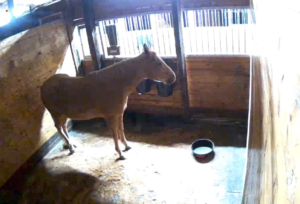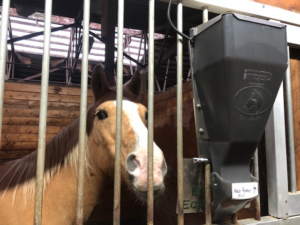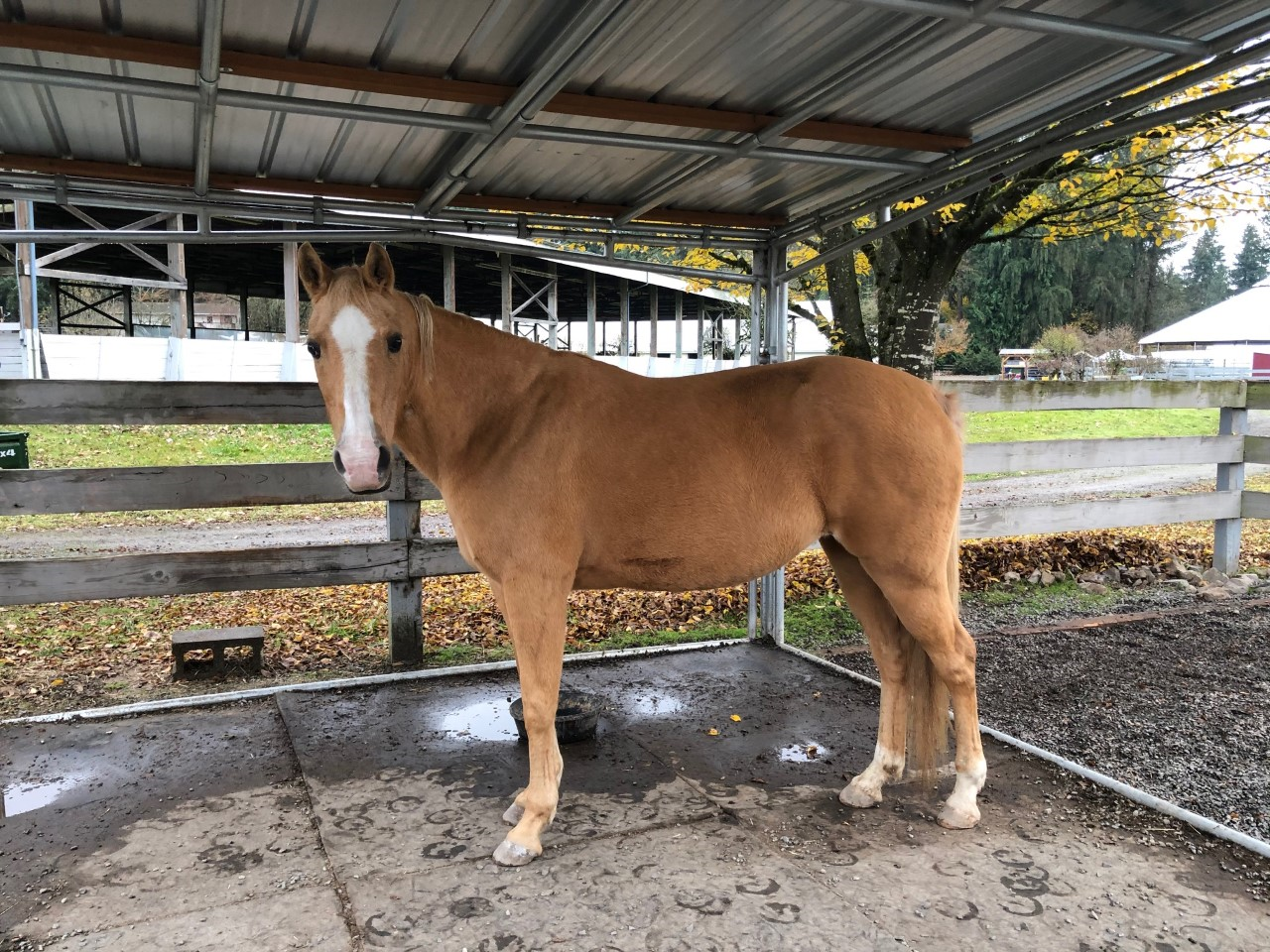Sweet Amelia has battled GI issues since before she arrived at SAFE. But so far, we had only seen her have one colic episode, and it was a minor one. But just before Halloween we found her down in her turnout, not wanting to get up. She hadn’t finished her most recent meal, which is very unlike her. She was given a dose of oral banamine, which did nothing to make her feel better. When it was clear that this wasn’t going to go away without veterinary attention, Dr. Lewis from Rainland Farm Equine Clinic came out to see her.
The strange part about this colic episode was that Amelia’s heart rate barely increased above normal range. An elevated heart rate while at rest is a typical giveaway that a horse is in some sort of discomfort. She wasn’t pawing, she wasn’t rolling, not doing most of the typical things you usually see in a horse who’s colicking. If she hadn’t gone off her feed and been lying down at a strange time, she might not have even drawn much attention to herself. But when you took a close look at her you could see that she was clearly uncomfortable. Dr. Lewis’ exam was fairly unremarkable, until she passed the nasogastric tube to administer fluids and electrolytes. Before adding anything into the stomach, veterinarians will check for stomach reflux in a horse. Presence of large amounts of fluid in the stomach is abnormal and indicates that there’s something causing the small intestine to not function properly. In Amelia’s case, she had a large amount of reflux present.
Dr. Lewis removed as much reflux from Amelia’s stomach as she could, and then performed an abdominal ultrasound. The ultrasound showed distended loops of small intestine. Because Amelia did not seem to be in excruciating pain, as you would likely see in something that would need surgery like intestinal entrapment or volvulus (twist), Dr. Lewis believed we were probably dealing with an enteritis. Enteritis in a nutshell is inflammation of the intestines. This was good news, because it meant that most likely Amelia was not facing something that could only be resolved with surgery. Dr. Lewis pulled blood, gave Amelia a dose of intravenous (IV) pain meds, and left the nasograstric tube in place. In this type of situation, the stomach will continue to fill with fluid and, because horses cannot vomit, the reflux will need to be removed on a regular basis until the problem resolves. This is something that I am able to do in house thanks to my training as a veterinary technician. As long as Amelia didn’t continue to get worse, we could try to manage her at home rather than hospitalizing her. I made plans to spend the night in the barn with Amelia and reflux her every 2 hours.
Dr. Lewis left SAFE and went back to the clinic to run the bloodwork. She called me a while later to check in. When I told her that the IV banamine and refluxing did not seem to improve her comfort level, we decided to haul Amelia to the clinic to be put on IV lidocaine. Lidocaine is a pain medication and can also improve gut motility. The dosage is very specific though so it needs an electronic fluid pump in order to administer it. Because of this, she would need to be transferred to the clinic. Amelia hopped into the trailer like a pro and we made the short trip to Rainland.
Upon arrival, Dr. Lewis placed an IV catheter and Amelia was put on fluids and started on lidocaine. I was allowed to still stay the night with her and continue to do the refluxing. She was producing so much reflux at that point that Dr. Lewis had me do it every hour instead of every 2. The worry with that is that the stomach can rupture if it’s allowed to become too full. Amelia was clearly not out of the woods, but we were doing everything we could for her.

Our view from the webcam
By about 3 AM, I had stopped being able to get much reflux out of her. Amelia was turning a corner in the right direction. She continued to get brighter and eventually the nasograstric tube was pulled and the IV fluids were stopped. She would spend the next two days at the clinic. One day for observation and allowing her GI tract to continue to settle, and another day to see if she could handle the re-introduction of food.
The remainder of her hospitalization was uneventful, and she handled the re-feeding well. She was discharged with a couple of medications and instructions to feed her a pound of equine senior every 2 hours. We set up the iFEED automatic feeder in her stall so she could have continuous feedings throughout the night, and we also placed our webcam in the stall so that we could monitor her after hours. We were also told to watch her closely for eating anything she shouldn’t be, and to make her wear a grazing muzzle if she did. Even though she is getting enough food for her weight, just getting a pound of feed per feeding doesn’t leave Amelia feeling very full so this was a concern. Without fail, the first thing she did when she was allowed turnout was start eating the leaves on the ground, so she earned herself a muzzle for turnout. She didn’t bother to eat the shavings in her stall for the first week or so that she was home, but eventually she began eating those, too. She can’t wear the grazing muzzle overnight because it doesn’t allow her to eat from the feeder, so we were left with no choice but to strip her stall of all the shavings.

Amelia loves her iFEED!
Amelia’s official diagnosis was anterior enteritis. We will likely never know exactly what caused it. If she continues to have issues in the future, we may have to take her to Pilchuck Veterinary Hospital for an internal medicine consult. But for now we’ll continue to monitor her closely and keep our fingers crossed that this was an isolated incident. We’re happy to have her home.


